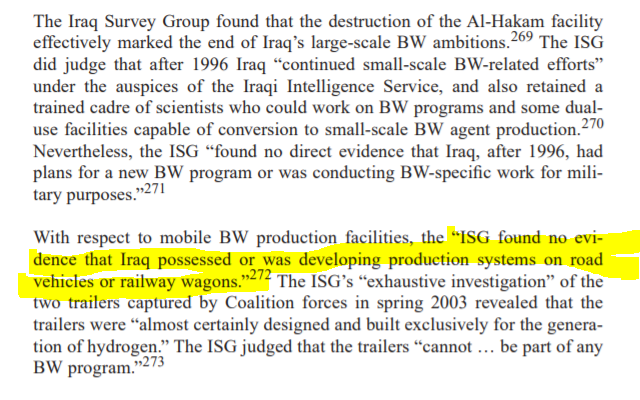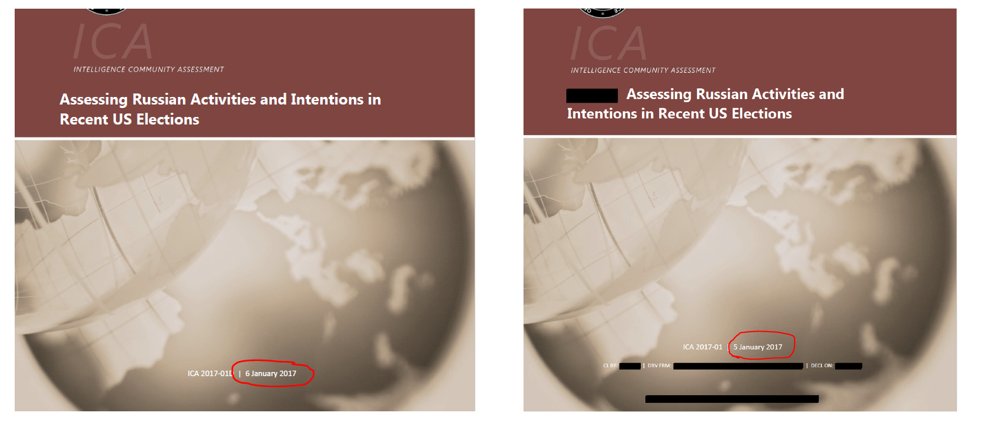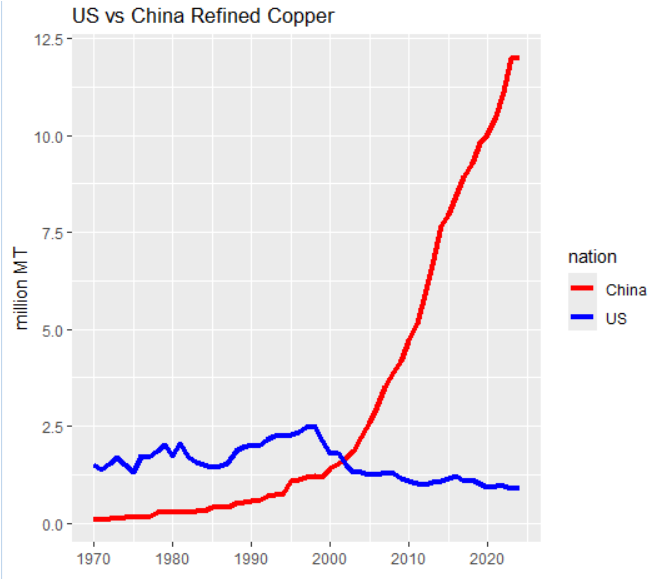the report of the WMD Commission in March 2005 is important to read (or re-read) in light of our present knowledge that Danchenko/Steele fabricated Steele dossier. fas.org/irp/offdocs/wm…
2/ perhaps their most important concern was that CIA intelligence officials "failed to convey to policymakers new information casting serious doubt on the reliability of a human intelligence
source known as Curveball", whose information was relied on in intel assessment.
source known as Curveball", whose information was relied on in intel assessment.

3/ the WMD Commission regretted that "once again", the intel community "failed to give policymakers a full understanding of the frailties of the intelligence on which they were relying." 

4/ fast forward to December 2016. While Steele himself had respectable (tho overblown) credibility within FBI, by late Dec, FBI knew that Steele's information came Danchenko, on whom they already had a file and had even questioned one of his sub-sources in June 2016.
5/ Danchenko had many of the same liabilities as Curveball. Nonetheless, FBI flouted and ignored every recommendation of WMD Commission about human source validation as they promoted Steele allegations in Jan 5 briefing to Obama officials, scaring the wits out of Yates and others
6/ when Danchenko was finally interviewed on Jan 24, 2017, FBI had information that (in words of WWMD Commission) should have "cast serious doubt on the reliability" of information that FBI had just given to policy-makers.
7/ but rather than reporting these problems to policy-makers, FBI doubled down and concealed the Danchenko information and the problems of Danchenko as a fabricating Curveball 2.0.
8/ turning to Curveball details. US intel assessment on Iraq bioweapons were based almost entirely on single "fabricator". There were a) failure to vet source; b) analyst credulity due to viewpoint bias; c) concealment of flaws when known 

9/ the slim independent "corroboration" for Curveball was information from a "source who was already known to be a fabricator" whose "information" was used by intel community even after fabrication known 

10/ WMD Commission observed that Presidential Daily Brief (PDB) - which had important role in Flynn fiasco - had pernicious impact on intelligence assessment, as combination of brevity and dailiness inimical to more considered and nuanced briefing 

11/ there's an interesting discussion of aluminum tubes, which in intel community "assessment" were said to demonstrate that Iraq had reconstituted nuclear program. Minority opinion that they were for conventional rockets ignored. 

12/ aluminum tube issue, oddly, connects to my parsing of climate proxy reconstructions (Hockey Stick), which I compared to an analyst "studying proxy evidence for WMD such as aluminum tubes. sometimes ... an aluminum tube is just an aluminum tube."
climateaudit.org/2006/06/14/a-f…
climateaudit.org/2006/06/14/a-f…

13/ as slight digression, I was rather fond of this comparison in the day. climateaudit.org/2006/08/09/ipc… I observed a valid HS wouldnt "vindicate statistical falsehoods of Mann HS", just as "belated discovery of some other type of WMD" wouldn't vindicate Powell on Al tubes as WMD proxy 

14/ the WMD Commission review fas.org/irp/offdocs/wm… of aluminum tube fiasco is worth reading in total and I won't precise it further as I want to get to Curveball.
15/ WMD Commission observed that intel assessment on Iraqi mobile bioweapons came "almost exclusively from a single source". So did allegations about collusion between Trump campaign and Russian intel services. From Steele's Primary Sub-Source. 

16/ Curveball was an Iraqi chemical engineer in Germany (Steele PSS was in DC area). German intel (like Steele with PSS) refused access to Curveball. Who, like PSS, provided prodigious volume of reports. 

17/ as another aside, the sheer volume of fake reports from Curveball should give pause to those neocons and pro-war "human rights" advocates who assert that it is "impossible" that ALL the chlorine attack allegations in Syria are false flag fakes. It isnt impossible; it's likely
18/ Curveball fabrications were incorporated into a 1999 intel assessment and again in a 2000 Special Intel Report based on supposedly "credible" reporting - the same adjective later applied by intel community to Steele and his PSS. 

19/ in 2001 and late 2002 in lead up to Iraq invasion, US intel community gave more and more "assertive" assessments on supposed Iraqi mobile bioweapon units. 

20/ in October 2002, as war drums beat louder and louder, the intel community assessment ratcheted its certainty on Curveball information even further. Into assertion that Iraq "has" bioweapon program that was larger and more advanced than before Gulf War 

21/ Brennan claims that CIA intel assessment that "Putin" was trying to assist Trump did not rely on Steele-Danchenko (Curveball 2.0). But, if so, it's hard to explain how Brennan's August briefing to Harry Reid included same false info about Carter Page and Sechin as Steele.
22/ but once again, Curveball precedent ought to have been cautionary. CIA purported to have independent sources for Iraqi bioweapon program, but they all recanted. "Second source", also emigre, recanted in Oct 2003. 

23/ a third supposed source (the "INC Source") had been assessed as a fabricator by May 2002. Nonetheless, in July 2002, intel community began to use his fabricated information in assessments, disregarding the prior finding that he was a fabricator. 

24/ by February 2003, the Curveball allegations had been inflated into a CIA Intelligence Assessment that Iraq has "wide range of biological agents and delivery systems" and was a threat to "US interests". 

25/ as with supposed "confirmations" of Steele dossier inventions, several objects discovered post-invasion were (incorrectly and temporarily) interpreted as confirmations of Curveball reporting. They weren't. 

26/ during the occupation of Iraq following 2003 invasion, a comprehensive investigation found "no evidence" of Curveball's mobile bioweapon production systems. It was all made up. 

27/ in 2005 (unlike 2017-2020), the intel community appears to have made a reasonably honest effort to understand their errors. They quickly determined that the bioweapon reported was thinly based on a single source - Curveball. 

28/ more later.
29/ continuing with WMD Commission analysis. They concede that agencies will sometimes "get burned", but found that inclusion of Curveball in assessments was "breakdown", noting "poor asset validation" and tendency of analysts to "believe that which fits their theories". 

30/ WMD Commission stated that intel community did "not even attempt" asset validation of Curveball. They note that Curveball was source to "foreign service" (Germany) which wouldnt provide direct access to Curveball, only reports. 

31/ in Danchenko situation. Steele refused to even identify Danchenko to FBI but FBI identified Danchenko as Steele PSS in late Dec but delayed one month. After interviewing Danchenko in late Jan, FBI commissioned a source validation report on STEELE (but seemingly not Danchenko)
32/ This was a belatedly late source validation on Steele (which Pientka had asked for in early November but McCabe-Priestap had refused). But isn't source validation on Steele at this point like asking for source validation on German intel agency instead of Curveball?
32/ the WMD Commission asked intel officials why they didnt "even attempt to determine Curveball's veracity". The answer is interesting and appears to recur in Steele incident: according to officials who distributed Curveball "information", it was responsibility of analysts 

33/ responsibility of analysts to "judge the contents" and if "analysts believe information is credible, then the source is validated". The argument that Danchenko-Steele dossier was "raw intelligence" is in same vein.
34/ both Senate Intel Committee and WMD Commission flatly rejected such abnegation of source validation as "serious lapse in tradecraft". 

35/ they then made important statement on validation. "Operational elements" must make "efforts to confirm source’s bona fides (ie, authenticating that source has access he claims), test source’s reliability and motivations, and ensure that source is free from hostile control" 

36/ now consider these criteria in respect to Danchenko. On Jan 24, 2017, FBI knew that Danchenko did NOT have the access to Millian that had been claimed in Steele dossier. Indeed, Danchenko admitted they had never met.
37/ even a cursory examination of Danchenko or Millian emails and social media - both easily accessible to FBI - would have confirmed that nothing attributed to "Millian" could have come from Millian. Keep this in mind as we see how source validation issues arose with Curveball
38/ returning to Curveball, in 2000, analysts had concluded that "Curveball’s information was plausible based upon previous intelligence, including imagery reporting, and the detailed,
technical descriptions of the mobile facilities he provided" and nothing “obviously wrong”
technical descriptions of the mobile facilities he provided" and nothing “obviously wrong”

39/ however, CIA Directorate of Operations began to raise questions about Curveball for much less than presented by Danchenko. First, one of the reasons for withholding Curveball from US was false: it turned out Curveball spoke "excellent English". (Recall "Russian-based" !?!) 



39/ second, the DOD detailee who met Curveball was concerned at his bad hangover when they met and was concerned that "Curveball might be an alcoholic" - an issue that also ought to have arisen with alcoholic Danchenko. 

41/ in April 2002, a "foreign intelligence service" (presumably UK) observed that “elements of [Curveball’s] behavior strike us as typical of individuals we would normally assess as fabricators”, but neither they nor US intel paid further heed 

42/ when evidence emerged that contradicted Curveball, analysts explained it away as "denial and deception" by Iraq. Even a wall across supposed path of mobile bioweapon trailers was explained away as deception by Iraq, rather than impugning Curveball fantasy. 

43/ in a second case, when satellite imagery failed to shown a facility claimed by Curveball, analysts explained it away as more deception by Iraq. 

44/ ironically, the behaviour of US intel agencies fit a classic criterion of "conspiracy theory" - the development of ever more elaborate hypotheses to explain away contradictory evidence. 

• • •
Missing some Tweet in this thread? You can try to
force a refresh

























